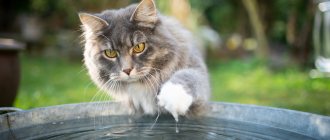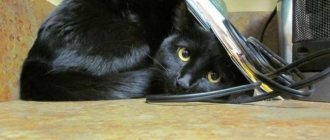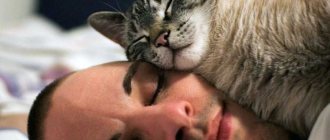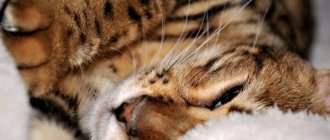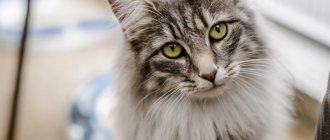It is believed that cats hate water, and it is believed that this is because they cannot swim. In accordance with their natural instinct, they avoid water so as not to accidentally drown, so they say. However, many owners have cats that love to play in bathtubs and pools. Large cat breeds such as jaguars and tigers are often seen swimming well and at great speed. This may make you wonder if your indoor cat will be able to swim to safety if it falls into the pool.
Cats can swim in water. This is a natural instinct that all cats have, and most of them automatically start paddling when they are underwater. Young kittens may be less agile than older cats and have difficulty swimming. However, they still have an instinct, and with age they will become more skilled at swimming. However, many domestic cats avoid water because it weighs down their fur and creates discomfort.
Some breeds of domestic cats don't mind this and are excellent swimmers. These include the Maine Coon, Bengal, Turkish Van, Savannah, Manx, Norwegian Forest Cat, Abyssinian and Japanese Bobtail. This may vary depending on the individual cat and her past traumatic experiences with water. Despite this, it is quite possible to teach a cat to swim.
Can cats swim instinctively?
Cats have an innate knowledge of how to swim. Like dogs, horses and other mammals, their survival instinct tells them to start paddling once they dive into the water. Depending on the cat's age and experience, the swimming technique may not be very graceful or efficient. However, almost all cats know to start swimming if necessary.
However, many cats simply choose not to do this. Some cats even have physical disabilities that limit their ability to push off with their paws or lift their heads above a surface.
Very young kittens are the least likely to swim if they need to. Since they are still learning to walk properly, swimming requires too much agility and energy from them, so they are at risk of drowning. Likewise, older cats may have a more refined swimming instinct, but have difficulty maintaining the strength needed to swim properly.
Many wild cats swim to wade across rivers or streams, chase prey, or even stalk it if necessary. For domestic cats, swimming is more of a survival instinct than a recreational activity. They will avoid the water, but would rather start paddling than simply drown.
Can a cat drown?
Even though cats are expert swimmers, it is still possible for a cat to drown. Drowning in cats occurs when liquid enters the respiratory tract and makes breathing difficult. Therefore, cats do not always need to be in a body of water to drown. If enough fluid enters the respiratory tract, the cat may die from drowning on land.
This occurs if the cat does not receive any care or medical attention. It's a slow and painful trek, so if there are large pools, lakes or rivers nearby, be careful. You should always supervise your cat around them. Most cats can swim well enough to avoid drowning, but it still happens.
As already mentioned, a kitten or older cat may not have enough mobility to stay afloat and avoid swallowing water. Even an adult cat can get stuck in rough water or run out of energy before it can get to land. If you haven't observed your cat swimming proficiently in the past, it's better to be safe than sorry.
Below is a short list of clinical symptoms in cats whose airway obstruction is caused by water. If your cat exhibits any of these signs, take her to the vet:
- Oversaturated wool
- Extremely fast or extremely slow breathing and/or heartbeat
- Increased abdominal effort when breathing
- Pale or blue gums
- Cough
- Collapse or loss of consciousness
How to make addiction easier
You need to wash in a shallow basin standing on the floor. Little kittens experience an instinctive innate horror at the sight of high sides of the bathtub and pouring water. They associate them on a subconscious level with flooding, which means they are a command to escape. It’s good if the cat managed to get acquainted with the basin, sniff it, and play in it before bathing.
Bath a kitten from the age of 4 months
Before the process itself, put the kitten in a basin, let it get used to it and run around side by side. Pour non-chlorinated water into it, no more than 5-7 cm. The most comfortable temperature is 38-40 degrees. Place the kitten in the basin. Quickly wet his head, being careful not to get water into his ears and nose.
You need to be patient, do not scold or shout at the baby while bathing; it is better to calm him down with kind words if he meows loudly, showing fear. Do not delay the procedure.
After bathing, the baby should be wrapped in a warm towel, thoroughly blotted, and encouraged: milk, a favorite treat, a toy. If you are shaking, it means you are freezing, you need to change the towel to a dry and warm one, hold it in your arms, and calm it down. Use only special, hypoallergenic shampoos.
Note! Kittens aged 1-3 months should not be bathed unless absolutely necessary. The optimal age for the first wash is 4 months.
If the baby gets dirty in the cat litter box, it is better to wipe it with wet wipes or wash only the paws, but do not bathe the baby completely.
How do cats swim?
Cats swim by paddling with their paws, keeping their heads above the water. Although swimming may seem easy, don't expect your cat to be able to swim underwater! She will not know how to do this and risks severe stress and drowning if she is forced below the surface of the water.
According to Brain Research, cats have very similar locomotor patterns when swimming as they do when walking. There are 2 common movements that cats perform in both cases:
- The left forelimb moves forward, followed by the right hindlimb.
- The left hind limb moves forward, followed by the right forelimb
These two patterns occur symmetrically on each side, meaning each movement pattern will appear equally on the left and right limbs. However, the movement patterns connect asymmetrically, on the right and left sides of the cat.
For example, when the left front paw moves forward, the right hind paw also moves forward. When the right front paw moves forward, so does the left hind paw. However, the forelimbs and hindlimbs on the same side do not move forward at the same time. Both when swimming and when walking, in order to move forward, you need to alternate these movements.
This allows cats to expend the least amount of energy while moving at the fastest possible speed. In water this becomes even more useful. The diagonal pattern allows them to maintain balance and draw in more water with each movement. If you find this difficult to imagine, carefully observe how your cat walks. You will notice these common movement patterns.
How far can cats swim?
Large, non-domesticated cat species (such as the tiger, jaguar and lion) can swim up to 9 miles. This is because they rely on water for thermoregulation, which helps them maintain a healthy body temperature. These predators are also known for searching for prey at the water's edge in their natural habitat. However, this does not apply to domestic species. Because:
- Domestic cats are much smaller than their wild ancestors, so they lack the strength and energy to get that far.
- Domestication over the years may have changed your cat's ability to swim long distances.
In particular, the process of domestication completely eliminated the need for domestic cats to swim. This can affect how much energy your cat expends in swimming and how long she can swim before giving up and heading to shore. Thus, it is difficult to determine the maximum swimming distance, since the cat will not attempt to reach this point. Therefore, the distance your cat can swim can vary widely. It depends on the:
- Does she like water first?
- her size
- breeds
How fast can cats swim?
The speed at which cats can swim has not been studied in detail. However, their swimming speed mainly depends on their body size. Like their wild ancestors, a cat's swimming speed is always much slower than a cat's running speed on land.
Interesting facts about waterfowl cats
The Turkish Van is considered a special waterfowl breed. Their front paws are equipped with special membranes that allow them to quickly row in the water, and their fur repels dirt and moisture well and practically does not get wet.
The Turkish Van is an excellent swimmer
The Turkish Van is an unsurpassed hunter; he chases not only rodents, his attention is attracted by various insects: beetles, butterflies, grasshoppers. If you need a fishing companion, he will be only too happy. He will happily spend time in nature, chasing a school of small fish in the shallows.
However, the fishing cat is rightfully considered the record holder for fishing. The wild swimming cat lives in southeast Asia (Indochina, Ceylon). Another name is speckled. Its weight can reach 15 kg. The cat has powerful jaws. It is unlikely that it would occur to anyone to tame an aggressive animal.
The front paws of the fishing cat, like those of the Turkish Van, are equipped with membranes. They prevent the claw plates from retracting and help in diving and fishing. With such equipment, it is not scary to swim long distances in search of prey. Swimming is his strong point, so the hunter lives near swamps, small lakes, and slow rivers flowing through tropical forests.
Cat fisherman with prey
We recommend viewing
Do cats mate with their siblings? Do cats miss their owners when they are returned home? Black Cats
On average, cats run at a top speed of 30 miles per hour. Therefore, you can expect cats to swim at half that speed, 15 mph, but this depends on their overall health and size.
It's worth noting that cats also rely on their balance to achieve great speed. In a Behavioral Brain Research 3 study, cats underwent bilabyrinthectomies, which disrupted their inner ears. They were able to compensate for some of their loss of balance using their vision, but they still had difficulty walking in a straight line.
In water, cats don't have to fight to maintain perfect balance. Therefore, older cats can develop greater swimming speeds, even if they have difficulty maintaining balance on land.
Reproduction [edit | edit code ]
The duration and timing of the breeding season of hares varies depending on the part of the range. Thus, in Western Europe it usually lasts from March to September; During this time, about 75% of females manage to bring 4 broods, and in years with warm winters and early spring - 5. In favorable climatic conditions, the rut continues all year, and the first hares appear in January. In the north of the range there are 1-2 broods. In central Russia, the first rut takes place at the end of February - March (males are active from January), the second - in April - early May, the third - in June. Pregnancy lasts 45-48 days, so the first hares appear in April - early May, the second brood - at the end of May - June (peak breeding), the third - in August. Hares mate again immediately after giving birth, and sometimes before them. In general, the rutting season of hare is not as smooth as that of white hare, so pregnant females and hares can be found earlier and later than normal seasons.
The number of hares in a brood ranges from 1 to 9. The size of the brood is influenced by many conditions. In general, litters are larger in areas where hares have fewer reproductive cycles. Winter, early spring and autumn broods are smaller than summer ones - they contain 1-2 hares. Middle-aged females bear the most litter. Before giving birth, females make primitive nests of grass, dig holes or, in hot climates, shallow burrows. The young hares are born sighted and covered with fur, weighing 80-150 g. The female comes to feed the offspring once a day, and sometimes less often - up to once every 4 days. From the 5th day of life, the hares begin to move near the place of birth; by 2 weeks they reach a weight of 300-400 g and are already actively eating grass, and at 3-4 weeks they become independent. There are known cases of female hares feeding other people's hares, provided that they are the same age as her own, but this is observed less frequently than with hare. Brown hares usually reach sexual maturity only the following spring; very rarely, in the western parts of the range, females begin breeding in the same summer. There are known hybrids of hare and white hare - cuffs. They were found both in nature and obtained from keeping hares in the zoo. When kept in captivity, cuffs are capable of reproducing.
The lifespan of hare is 6-7 years (in exceptional cases they lived up to 10-12 years), but most of the animals live no more than 4-5 years.
Do cats like to swim?
Answer: mostly yes, and partly no. Most domestic cats do not like water, much less swimming, and are even afraid of it. However, several types of cats are not afraid of water and even swim happily if given the opportunity.
Why do cats hate water?
It's not the water itself that cats hate, it's what the water does to their fur. In particular:
- Saturated fur seems heavy
- Wet fur takes too long to dry
- Fur saturated with water limits the ability to hunt and maneuver.
Cat fur tends to expand when exposed to water. A healthy cat's fur can absorb more than 30% of its weight in water. This percentage can increase significantly in damaged fur.
In addition, the length of the fur may increase by 2%, and the diameter of the hair may increase by 15-20% compared to dry hair. However, this largely depends on the health of the fur and hair follicles. Therefore, it is not surprising that wet fur can cause a lot of trouble.
It is very important for cats to maintain the correct body temperature (ideally 100 degrees Fahrenheit). Wet fur can disrupt this optimal temperature, causing cats to become very cold. This can lead to serious illnesses such as hyperthermia if the cat is unable to dry quickly.
How to train your pet not to be afraid of bathing
You need to get used to the process of bathing gradually. You should not bathe a kitten until 4 months of age - this can lead to severe hypothermia and a decrease in immunity.
Do cats need to be washed at all?
We must remember that the wild brothers and ancestors of modern domestic purrs were inhabitants of dry steppes who ate fresh prey and did not need additional drink. In addition, whiskers are very clean creatures that do an excellent job of tidying themselves up with the help of their tongue. By licking themselves, they break down contaminants with their bactericidal saliva and easily get rid of them.
A pet rarely needs to be washed by a person. Moreover, some veterinarians are against this procedure, because it is fraught with complications and is almost always accompanied by negative emotions.
You should not bathe your pet more than once a quarter, but it is better to carry out the procedure 2-3 times a year. The only exception may be an allergic reaction to the fur of a furry friend on the part of the owner and family members. Other reasons to wash your pet:
- the cat is not very clean;
- Dirt cannot be removed by regular licking;
- the wool gives off an unpleasant odor;
- ectoparasites (fleas, lice eaters, etc.) appeared on the body.
The need to use detergents is also associated with the prevention of skin diseases. In addition, if a handsome man with a mustache participates in exhibitions or championships, then he will have to be tidied up before each public appearance.
6 stages of training
A furry dog of any age will react negatively to the owner’s attempts to put him in the bath. Therefore, so that the cat is not afraid of water, it must be gradually accustomed to washing.
It’s good to start by introducing the mustache to the environment in the room. The animal must sniff everything, get used to unknown sounds and smells.
Experienced owners advise putting the animal in a dry bath and putting his favorite toys in there. Over time, the animal will stop panicking and running away. Then you can begin the first bath procedure. It occurs in several stages:
- Pour a few centimeters of water into a bathtub or basin and place a towel or mat there to prevent the mustache from slipping.
- Slowly lower the animal into the container.
- Wet your pet's fur. If he is calm, then you can turn on the shower.
- Lather your body with shampoo and massage thoroughly. Do not allow foam to get into your pet's ears, nose or mouth.
- Rinse off the shampoo and remove the cat from the container.
- Dry the wool with a towel and then wrap it in a dry sheet or other towel.
After bathing, it is not recommended to dry the animal's fur with a hairdryer. This can be scary and uncomfortable. The first wash should not last long. In the future, the duration of the procedure is determined individually.
Alternative to washing
If your pet's fur is not dirty, then you shouldn't bathe it. For individuals with short hairs, it is best to simply comb them periodically. Long-haired representatives are combed regularly, and during the molting period they do this 3 times a week.
A wet towel, which is used to wipe the soiled part of the body, will help get rid of light stains. Some owners of animals participating in exhibitions and championships use dry shampoos. These products clean the coat well, and do not need to get it wet.
Conclusion
The fear of domestic purrs of water and the manipulations carried out in it can be explained. Cats are afraid of water literally at the level of instincts. They don't want to be noticed, freeze or overheat, go deaf or catch a bad cold.
Inexperienced owners try to break their pet's reluctance by force, forcing him to endure unpleasant moments. The best way is to gradually accustom the animal to the bath, without coercion or punishment. Only in this case will the pet mustache positively perceive bath procedures.
The article is a recommendation!
Why are domestic cats afraid of water?
Domestic cats are afraid of water mainly for the above reasons. This can be seen as fear, as cats actually have an aversion to water and will try to avoid it. Because fear is often a survival method to avoid dangerous situations, according to Summa, Animali da Compagnia, some cats do exhibit true phobias. However, most of them simply react with disgust to the effect of water on their fur.
Some studies have hypothesized that fear of water may be due to evolution. The ancestors of the domestic cats we know and love today were desert cats. Being in the desert, they could not be near many bodies of water. Therefore, their descendants, in the process of evolution, began to fear water, since it was something unfamiliar to them.
However, a strong fear of water may arise due to past experience or due to the characteristics of the breed. For example, if a cat has had a bad or traumatic experience with water in the past, then it is likely that she will grow up to be afraid of water. Negative associations with water can range from minor inconveniences to serious injuries, such as:
- accidental ingress of water
- Staying in the rain without being able to dry out and getting sick
Water aversion is not easily overcome in these cats, so don't try to force it unless you have a logical reason to do so. You can also enlist the help of an animal behaviorist if you are serious about helping your cat overcome his fear of water.
Cat breeds that love to swim:
Some cat breeds are more tolerant of water than others. However, this is a generalization based on certain physical characteristics that they possess. It should not be assumed that this applies to all individuals of a given species, since each cat is individual.
Plus, a bad experience will overshadow the fact that many of these cats love water. Here is a list of cat breeds that are most likely to love swimming:
- Maine Coon
- Bengali
- turkish van
- Turkish Angora
- Savannah
- Manx
- Norwegian Forest Cat
- Abyssinian
- american bobtail
- Japanese Bobtail
Causes
Through observations, experts were able to find out that cats are not at all afraid of water. Of course, among the mustachioed-striped population there are probably individuals with phobias, but we are talking about the majority. However, the vast majority of cats are very reluctant to come into contact with water, and there are a number of very good reasons for this.
So, cats are afraid of water because it can increase body odor. In nature, wild cats bathe very rarely; they do this to improve the health of their fur and skin. After getting wet, the skin glands begin to actively produce sebum, which should cover the entire coat. A few days after bathing, a cat may emit a rather strong, specific odor, which will negatively affect two aspects:
Hunting – a wild cat obtains food only by hunting. A strong smell will give away the predator and he will remain hungry. Typically, for wild cats, the bathing period occurs during extreme heat, when the animals' appetite is naturally suppressed.
Danger from larger predators - everything is cyclical in nature, a cat is a hunter, but it can also become a victim of a larger animal. A strong smell from fur gives away not only the cat, but also its habitat. After swimming, wild cats do not return to their usual habitat, but spend a day (sometimes more) near the reservoir.
The only means of heating a cat is wool. In normal condition, a cat's coat is dry and lubricated with sebum, which repels water. Regardless of the presence of undercoat, there is a space between the coat and the skin of the cat, the so-called chamber. The chamber contains air whose temperature is stable and equal to the cat’s body temperature. After getting the wool wet, the air chamber is destroyed, which disrupts thermoregulation.
When it comes to a domestic cat and the bathing process, the owner must understand that simple bathing procedures can result in a cold. Until the cat's fur is completely dry, a draft is very dangerous for the animal. In the wild, no one will wrap a cat in a towel, and it cannot be protected from drafts. Hypothermia is a very serious condition, after which the tailed cat may develop pneumonia. Pneumonia can be treated, but it is difficult, and a wild animal is guaranteed to die from this disease.
Most likely, you are thinking, why are cats afraid of water all year round, because in the summer it is hot even with wet fur. The reason is that the thermoregulation of cats, or more precisely, the process of cooling the body of a purr, differs from that of humans. When a person is hot, he sweats and quickly cools down, but a cat does not have sweat glands on its body. The air gap mentioned above allows you to maintain a stable body temperature not only in the cold, but also in the heat.
Wet wool heats up more strongly in direct sunlight, since water is a good conductor of heat. If the cat has a dark color, then its wet fur will be very hot. The cat’s body heats up and it’s difficult for her to fight, so the pet opens its mouth and begins to breathe heavily. The saliva evaporates and allows the tailed animal to cool a little from the inside. However, if the cat is already breathing with its mouth open, most likely it has already suffered heatstroke and needs your help.
Why do some cats love to swim?
Cat breeds that love to swim also differ in the quality of their coat. For example, the Turkish Van is known for its cashmere-like, almost water-repellent long fur. It is an excellent swimmer with strong hind legs and large paws that help it move easily in the water.
Other cat breeds, such as the Turkish Angora, Maine Coon and Norwegian Forest Cat, have water-repellent fur. This allows them to enjoy swimming much more.
Of course, this may be associated with the experience of their ancestors. For example, the Manx is a breed developed from a cat that lived on the isolated Isle of Man. Since her ancestors lived on an island surrounded by water, this may be why the Manx has no fear of water.
Domestic Bengal cats are an interesting case because they typically live only 4 generations from their ancestor, the leopard cat. Perhaps this is why they do not have an aversion to water, unlike other cats. They just recently left their leopard ancestor, who is not so afraid of water. In fact, leopards often swim and even occasionally hunt in the water for fish and crabs.
Breed Features
All cats are good swimmers. But there are breeds whose representatives are more lovers of water treatments. What do they include:
- Maine Coon. These are large fluffy pets native to the USA. Despite their large size, they are very friendly and non-aggressive. They are also lazy in nature and love to sleep and relax. But during water procedures they show increased enthusiasm and playfulness. Owners should prepare in advance for bathing, as the process can leave them wet from head to toe.
- American Bobtail. Another representative of domestic cats from the USA. This breed has many traits typical of dogs. These cats are easy to train, require walking, and have a positive attitude towards water procedures.
- Turkish van. This is a special waterfowl breed. Its representatives even have small membranes on their front paws. There are six of them that have water-repellent and dirt-repellent properties, so they are not afraid of getting wet. The Turkish Van is active and playful, he loves to hunt small rodents and bugs, and you can also go fishing with him.
- Bengal cat. She has short, very soft fur with an original color that makes her look like a leopard. Bengal cats are smart, curious and willful. They love affection, but do not tolerate it when it is imposed. The same applies to swimming: by nature they know how to swim well, but they will decide for themselves when to do it.
- Soukok (African Shorthair). The main characteristics of this breed are the original color (creating a resemblance to a wild animal) and elongated hind legs. Cats are affectionate and active and love to play on land and swim. They will happily frolic in the bathroom, playing with the faucet or with their toys.
How to teach a cat to swim
If you want to teach your cats to swim, you're in luck. It's really possible! However, there are a few things you need to understand about teaching cats to swim:
- Teaching older kittens to swim increases the likelihood of success.
- Teaching cats to swim requires a lot of patience and time.
- Cats are likely to complain by squirming, biting and scratching. Don't take it personally, but listen to their body language.
Kittens are much more amenable to “sculpting” in terms of teaching them behaviors and tricks. However, this doesn't mean you can't teach older cats to swim.
No matter what age you start training your cat, training requires a lot of patience and time. Remember that these animals are generally not designed to love water! You are simultaneously teaching them to overcome their fears and be willing to swim, which is not easy to do in a short time.
Introduce your cat to water
Start by making your cat feel comfortable approaching water. If you have a pool, a normal size or even a children's one, start there. Try to see if your cat can come to you when you are in the water.
If the cat doesn't seem receptive, you can use your bathtub and leave the bathroom doors open. This will allow the cat to explore. It's helpful to have treats on hand. Do not touch the cat with wet hands or splash water on it.
Give her a whirl
When your cat calmly approaches you and your pool or bathtub, bring her inside. Slowly dip small areas of the cat's body.
If you add it to your pool, make sure the chlorine level is below 4 mg per liter for added safety. This will also reduce the likelihood of the cat being scared away by the smell.
Start by immersing the tips of the cat's paws, tail, or lower abdomen. Make sure your cat is held comfortably and firmly. Monitor her behavior and remember to reassure her because she will complain. If the cat feels comfortable, sit in the water, holding her in your arms and making sure her head remains above the water level.
Main reasons for fear
The fear of water has been instinctively ingrained in cats since ancient times.
Even the ancestors of representatives of the cat family had no need to contact the aquatic environment to obtain food, hunt mice and rodents, and getting wet caused only one problem: Impaired heat exchange. When a cat's fur gets wet, it loses its insulating function, causing the animal to become very cold.
Infections. Dirt actively adheres to wet fur, which leads to the accumulation of bacteria and other pathogens, and this is extremely dangerous for the cat’s health.
Smell. The wet fur begins to smell quite strongly. This specific aroma interferes with hunting, scaring away potential prey, and also attracts dangerous predators.
Overheat. During the hot season, the wool layer performs a protective function, protecting the cat’s delicate skin from exposure to aggressive ultraviolet rays. When the coat gets wet, the protective function is lost, and the animal can suffer seriously from overheating.
Wash off protective lubricant. Cat fur is coated with a special protective lubricant, invisible to the naked eye, which gives it shine and luster and protects it from breakage and loss. Frequent contact with water leads to degreasing of the animal's fur and skin and worsens its condition.
Drying time. After bathing, as the results of numerous studies and experiments have shown, a cat needs at least several hours to get its fur in order.
Chlorinated water. Animals have an extremely negative attitude towards the smell of chlorine, which is characteristic of tap water. This problem can be solved by using pre-boiled and settled water for bathing.
Misbehavior of the owner. Often, due to the careless actions of the owners during the bathing process, water gets into the pet’s ears, which can lead to serious consequences, including inflammatory processes and deterioration of hearing function.
Therefore, it is necessary to exercise great caution when bathing your pet, and even better, place protective cotton swabs in the ear canals of the purr in advance and avoid getting copious amounts of liquid on the cat’s head.
However, some cats happily splash in the water without experiencing any fear.
Cat breeds that are comfortable with water
It is somewhat strange that fish lovers cannot stand water - the element in which their food floats. Even an ordinary yard cat can sometimes take a risk and catch a careless fish that has washed up on the shore, and there are animals from the cat family that, due to their breed, are not afraid of water and are constantly engaged in fishing.
Siamese cats perceive water absolutely calmly
One of these is the Kurilian Bobtail. Cats of this breed not only boldly enter the water, not only swim, but also dive and hunt underwater.
Siamese cats also take water absolutely calmly. These pets do not fish, but they allow themselves to be washed and even enjoy the procedure. This reserved behavior is explained by a legend - in ancient times, Siamese cats were allowed into the baths where royalty washed. Animals close to the august ones watched the bathing and allowed their tails to be used as temporary storage for precious rings. Felinologists have a more prosaic explanation - Siamese cats have a love of water at the genetic level.
The Kurilian Bobtail calmly swims and dives in the water
What do hares eat?
The diet of animals is based on plant foods in the form of bark, young shoots, grass, berries, vegetables and fruits. Hares living in temperate latitudes prefer clover, dandelions, sedge, yarrow and alfalfa. In the summer, there is always enough food for them, since they can easily taste blueberry shoots and berries, mushrooms, as well as the fruits of wild apple and pear trees.
With the onset of cold weather, hares have to switch to pasture, so they begin to feed on tree bark, as well as annual shoots. In the harshest winter periods, hares pull out various roots and dried grass from under the snow.
Cold and hot shower
When you take your pet in your arms, you always feel the warmth emanating from him. This is due to the fact that cats have a higher temperature than ours, and, therefore, the temperature of the water when bathing the animal must be made hotter than we are used to doing for ourselves. For a pet, this means washing in ice water. How many people do you know who will be grateful to you for a forced ice shower and will stand silently, not trying to escape? The skin receptors in a cat, like any other warm-blooded creature, perceive this as violence. And if they beat you, you have to run.
Cats don't really like the smell of perfume, especially if they start rubbing it into their fur. For small predators, such a fragrance is similar to the smell of fertilizers for us. Imagine if you started lathering your lady with something similar. It is unlikely that you would get away with scratches and a dissatisfied look.
Wet wool smells bad
The video clearly demonstrates why cats are afraid of water: watch any of the popular videos - a wet cat either screams, or breaks out, or freezes and shrinks, as if trying to shrink in size, appear small and invisible.
Why does she react this way? Apparently, because the animal’s hunting instinct or self-preservation instinct is triggered: while waiting for prey or hiding from ill-wishers, cats hid and tried not to give themselves away, not even by smell.
Truth or Myth
Of course, this is actually just a legend. In fact, felines are excellent swimmers. This applies to tigers, panthers, pumas and many others. Why should the domestic cat be an exception?
Another question is that the vast majority of cats simply do not like to swim, or rather, to get their skin wet. We'll talk about the reasons for this a little later. All mammals, without exception, can swim. Cruel and rational evolution has long since eliminated all those not endowed with this skill. After all, there are quite a lot of critical situations when cats rush into the water without hesitation :
- The need to escape in a flood.
- Everyday hunting.
- Fleeing from a more dangerous enemy.
This is not a complete list of reasons for cats to plunge into water, including ice water. True, modern pets simply do not find themselves in such situations. They are not threatened by flooding, food is obtained in a bowl, and they usually do not encounter predators that pose a threat.
Many cat owners say that their pets love to swim or at least sit in the water. Despite this, on the Internet you can easily find hundreds of videos with scenes of cats swimming - they quite successfully overcome large water obstacles. Others don’t swim, but they like to sit in warm water, in the bathroom.
Human-induced contact
The procedure of bathing a cat deserves a separate discussion, it is difficult for both the animal and the person. Why are cats afraid of warm, pleasant water, after which they turn from hopeless dirty creatures into neat, cute pets with silky fur? Here you need to take into account the fact that a cat is a freedom-loving animal that does not tolerate anything imposed. She even goes into arms only when she wants it.
And here, not only was the animal grabbed against its will and began to squeeze (showing tenderness is a standard preparation for bathing), but a tub of water was also poured on its head.
What people consider pleasant and comfortable (warm water, fragrant shampoo), cats consider unpleasant and useless (and why use a tongue that can perfectly lick yourself?).
In addition to water itself, cats may not like scented washing products: they are disgusted by the smell of even not very scented soap; ordinary shampoos used by owners can cause an allergy in the cat, manifested in dryness, peeling and redness of the skin (symptoms are not visible under the fur, but they are very annoying for the pet), as well as sticking and dulling of the fur.
When asked why cats are afraid of water, Wikipedia gives the answer that moisture negatively affects the air cushion located in the cat’s undercoat area - it literally washes it away. And until the animal dries out after water treatments, it feels very uncomfortable - after bathing, the cat’s body temperature drops by 5-7 °C, and the animal constantly trembles even under a towel.

